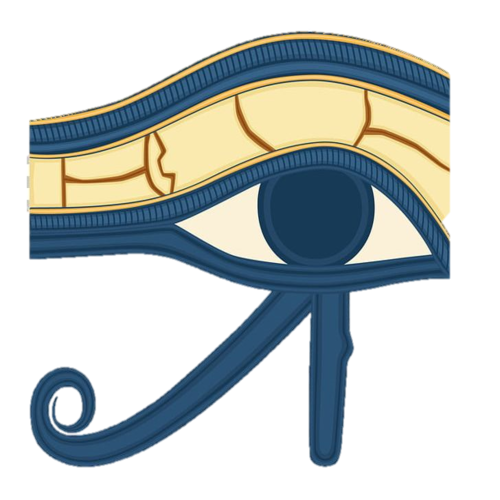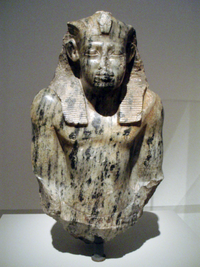| Preceded by: Amenemhat I |
Pharaoh of Egypt Twelfth Dynasty |
Succeeded by: Amenemhat II | ||||||||||||||||||
| Senusret I | ||||||||||||||||||||
|---|---|---|---|---|---|---|---|---|---|---|---|---|---|---|---|---|---|---|---|---|
| Reign | 1971 BC to 1926 BC | |||||||||||||||||||
| Praenomen |
Kheperkare The Ka of Re is created | |||||||||||||||||||
| Nomen |
Senusret Man of Wosret | |||||||||||||||||||
| Horus name |
Living of births | |||||||||||||||||||
| Nebty name |
Living of births | |||||||||||||||||||
| Golden Horus |
Living of births | |||||||||||||||||||
| Father | Amenemhat I | |||||||||||||||||||
| Mother | Neferitatenen[1] | |||||||||||||||||||
| Consort(s) | Neferu | |||||||||||||||||||
| Issue | Itakayt, Sebat Ameny, Amenemhat–ankh | |||||||||||||||||||
| Burial | Pyramid at el-Lisht | |||||||||||||||||||
| Monuments | White Chapel | |||||||||||||||||||
Senusret I was the second pharaoh of the Twelfth Dynasty of Egypt. He ruled from 1971 BC to 1926 BC, and was one of the most powerful kings of this Dynasty. He was the son of Amenemhat I and his wife Nefertitanen. His own wife and sister was Neferu. She was also the mother of the successor Amenemhat II.
He continued his father's aggressive expansionist policies against Nubia by establishing Egypt's formal southern border at the fortress of Buhen near the Second Cataract. He also organized an expedition to a Western Desert oasis in the Libyan desert. Senusret I established diplomatic relations with some rulers of towns in Syria and Canaan. He also tried to centralize the country's political structure by supporting nomarchs who were loyal to him. His pyramid was constructed at el-Lisht. Senusret I is mentioned in The Story of Sinuhe where he is reported to have rushed back to the royal palace in Memphis from a military campaign in Asia after hearing about the assassination of his father, Amenemhat I.
Building program
He dispatched several quarrying expeditions to the Sinai and Wadi Hammamat and built numerous shrines and temples throughout Egypt and Nubia in his long reign. He rebuilt the important temple of Re-Atum in Heliopolis, the centre of the sun cult – and erected 2 red granite obelisks there to celebrate his Year 30 Heb-sed Festival. One of the obelisks still remains and is the oldest standing obelisk in Egypt. A well known open bark shrine (known as the White Chapel) with fine, high quality reliefs of this ruler, was built at Karnak to commemorate his Year 30 jubilee; it is still on display, having been rebuilt from various stone blocks by Henri Chevrier in 1926. Finally, Senusret remodelled the Temple of Khenti-Amentiu Osiris at Abydos, among his other major building projects.
The court
The court of Senusret is quite well known. Vizier at the beginning of the reign was Infefiqer known from many inscriptions and from his tomb next to the pyramid of Amenemhat I. He seems to have stayed quite long in his office and was followed by a certain Senusret. Two treasurers are known from the reign of the king. Sobekhotep (year 22) and Mentuhotep. The latter had a huge tomb next to the pyramid of the king and he seems to have been the main architect of the Amun temple at Karnak.
Sucession
Senusret himself was crowned coregent with his father in his father's 20th regnal year.[2] Towards the end of his own life, he appointed his son Amenemhat II as his junior coregent as well. The stele of Wepwawetō is dated to the 44th year of Senusret and to the 2nd year of Amenemhet, thus he would have appointed him sometime in his 43rd year.[3] He died sometime in his Year 46 since the Turin Canon ascribes him a reign of 45 Years and a lost number of months.[4]
References
- ↑ *W. Grajetzki, The Middle Kingdom of Ancient Egypt: History,Archaeology and Society, Duckworth, London 2006 ISBN 0-7156-3435-6, p.36
- ↑ Murnane, Willaim J. Ancient Egyptian Coregencies, Studies in Ancient Oriental Civilization. No. 40. p.2. The Oriental Institute of the University of Chicago, 1977.
- ↑ Murnane, Willaim J. Ancient Egyptian Coregencies, Studies in Ancient Oriental Civilization. No. 40. p.5. The Oriental Institute of the University of Chicago, 1977.
- ↑ Murnane, Willaim J. Ancient Egyptian Coregencies, Studies in Ancient Oriental Civilization. No. 40. p.6. The Oriental Institute of the University of Chicago, 1977.


